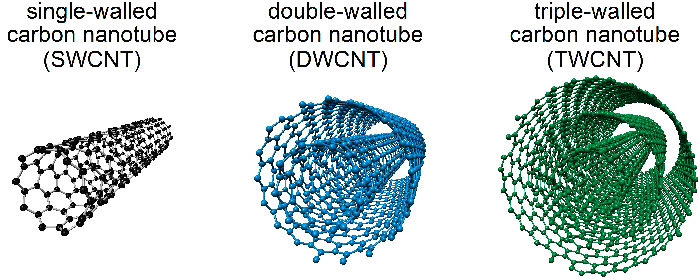“The analyses allowed us to study fundamental properties such as intertube mechanical coupling, wall-to-wall (WtW) distance and metallicity- and curvature-dependent intertube interactions,” he told nanotechweb.org. “Such knowledge will be of fundamental importance for technological applications that exploit these nanostructures.”
The researchers characterized five individual TWCNTs in detail and found that the WtW distance between the inner two tubes in all the samples ranges from 0.323 to 0.337 nm. These values are larger than the WtW distance observed in previously studied DWCNTs (0.284–0.323 nm), and lie closer to the interlayer distance in graphene itself (0.335 nm). “We also found that the intertube interactions affect innermost nanotubes differently according to which metallicity they have and that the elusive mechanical coupling between the radial breathing mode, or RBM, of concentric nanotubes does not exist, even for relatively short WtW distances of 0.323 nm,” added Hirschmann. “This is an important finding and shows that, although the TWCNTs are hybrid systems, the tubes themselves are mostly independent of one another.”
The RBM is the most important spectroscopic signature of a CNT, whose frequency of vibration is known to be inversely proportional to the tube diameter, he explained. These so-called first order Raman features provide a wealth of information on the electronic and vibrational structure of these nanomaterials.
“Our analyses also shed more light on the van-der-Waals forces mediating the interactions in concentric ordered CNTs, such as DWCNTs and TWCNTs,” said Araujo. “These low-energy interactions are important for technology applications because they affect the electronic and vibrational properties of the tubes.”
The team is now busy analysing shielding phenomena and intertube interaction effects in multi-walled carbon nanotube systems. Here, intertube interactions not only affect the measured RBMs but also other Raman features. “One of our main goals is to find better conditions in which to grow CNTs by controlling interactions between nanotubes walls,” said Hirschmann. “To this end, we are working closely with Yoong Ahm Kim and colleagues at Shinshu University, who are experts when it comes to synthesising these nanomaterials.”
The present research is detailed in ACS Nano.

